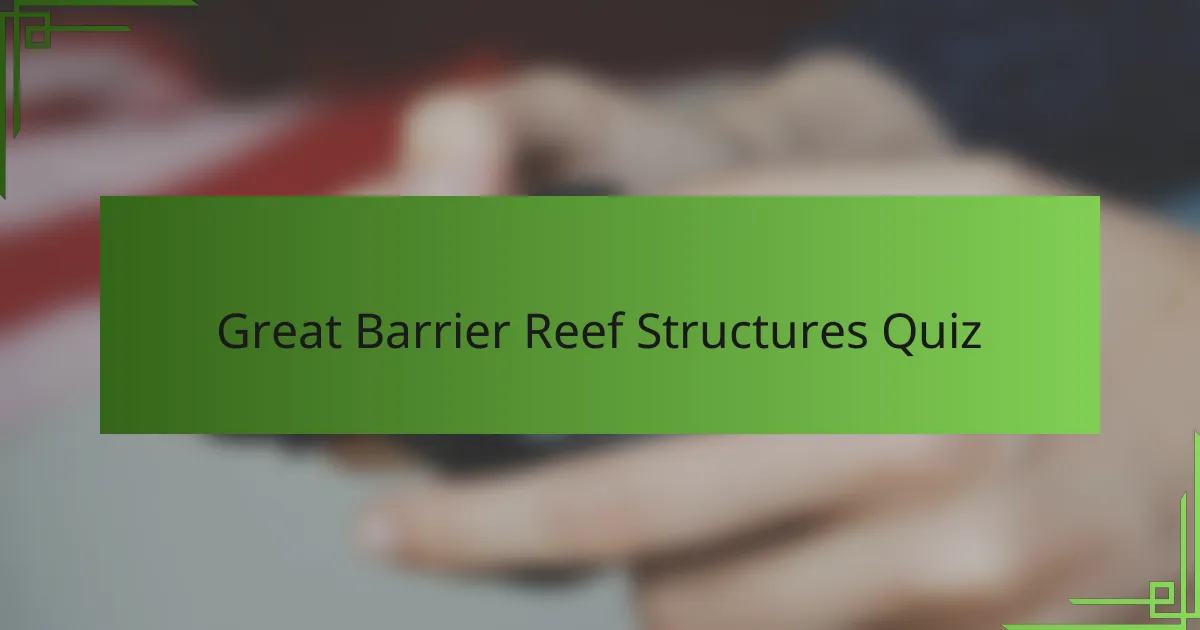
Great Barrier Reef Structures Quiz
1. What is the largest coral reef structure within the Great Barrier Reef system?
- Hardy Reef
- Osprey Reef
- Agincourt Reef
- Ribbon Reef No. 10
2. Which island in the Great Barrier Reef is famous for its unique perched dune system?
- Hamilton Island
- Heron Island
- Lady Elliot Island
- Green Island
3. What is the name of the notable reef structure known as the world`s largest coral cay in the Great Barrier Reef?
- Hamilton Island
- Lizard Island
- Heron Island
- Lady Elliot Island
4. Which reef in the Great Barrier Reef is recognized for its extensive coral bommies formations?
- Heron Reef
- Hardy Reef
- Ribbon Reef No. 10
- Osprey Reef
5. What is the name of the prominent reef located near Cairns in the Great Barrier Reef?
- Coral Sea Reef
- Mackay Reef
- Whitsunday Reef
- Great Barrier Reef
6. Which island structure in the Great Barrier Reef is a popular base for diving expeditions?
- Hamilton Island
- Heron Island
- Lizard Island
- Dunk Island
7. What geological formation characterizes the Ribbon Reefs within the Great Barrier Reef?
- Elongated coral reef structures
- Sandstone barrier ridges
- Volcanic seamount chains
- Limestone karst formations
8. Which lagoon within the Great Barrier Reef contains numerous coral reefs and islands?
- The Whitsunday Lagoon
- The Capricorn Lagoon
- The Torres Strait Lagoon
- The Coral Sea Lagoon
9. What is the name of the reef system that forms the northernmost part of the Great Barrier Reef?
- Ribbon Reefs
- Capricorn Reef
- Swain Reefs
- Torres Strait Reef
10. Which island in the Great Barrier Reef is known for its significant population of green sea turtles?
- Heron Island
- Raine Island
- Lady Elliot Island
- Lizard Island
11. What is the name of the coral formation known as the `Heart Reef` in the Great Barrier Reef?
- Coral Heart Atoll
- Heart Reef
- Star Reef
- Love Reef
12. Which reef structure in the Great Barrier Reef is a UNESCO World Heritage site landmark?
- Ribbon Reef
- Cod Hole
- Heart Reef
- Osprey Reef
13. What type of coral structure forms much of the Great Barrier Reef`s underwater landscape?
- Atoll coral reefs
- Barrier coral reefs
- Fringing coral reefs
- Patch coral reefs
14. Which cays in the Great Barrier Reef are famous for their white sandy beaches and birdlife habitats?
- Fitzroy Island
- Lady Elliot Island
- Heron Island
- Magnetic Island
15. What is the name of the channel that separates the Great Barrier Reef from the Australian mainland?
- Coral Sea Channel
- Torres Strait
- Endeavour Passage
- Great Coral Trench

Congratulations on Completing the Great Barrier Reef Structures Quiz!
Thank you for taking the time to explore the fascinating geography of the Great Barrier Reef through this quiz. As you answered each question, you delved into the unique structures that make this natural wonder so special. This process not only tested your knowledge but also enhanced your understanding of coral formations, reef ecosystems, and their geographical significance.
Throughout the quiz, you likely discovered interesting facts about how the reef’s structure supports diverse marine life and contributes to the ecological balance of the area. You may have learned about different types of coral formations and the geological processes that shaped this extensive reef system. These insights offer a deeper appreciation of why the Great Barrier Reef is a critical subject for both environmental science and geography enthusiasts.
If you want to continue building on what you’ve learned, we invite you to visit the next section on this page. There, you will find detailed information about the Great Barrier Reef’s structures, including maps, diagrams, and further explanations. This will help expand your knowledge and provide a more comprehensive understanding of one of the world’s most remarkable geographical features.

Great Barrier Reef Structures
Overview of the Great Barrier Reef Structure
The Great Barrier Reef is the world’s largest coral reef system, located in the Coral Sea, off the coast of Queensland, Australia. It stretches over 2,300 kilometers and is composed of roughly 2,900 individual reefs and 900 islands. The structure of the reef is formed by billions of tiny organisms called coral polyps, which secrete calcium carbonate to build the reef’s hard skeleton. This geological formation represents the largest single structure made by living organisms, making it a prominent topic in geography and marine sciences.
Coral Reefs and Atolls in the Great Barrier Reef
The Great Barrier Reef contains a variety of coral reef structures, including fringing reefs, barrier reefs, and numerous atolls. The fringing reefs are directly attached to the shore or border islands, whereas barrier reefs lie further offshore, separated by lagoons. Atolls, circular or oval coral reefs surrounding a lagoon, are rare but present within the Great Barrier Reef system. These structures demonstrate the reef’s dynamic development over time through geological uplift and sea level changes.
Role of Coral Polyps in Building Reef Frameworks
Coral polyps, the primary bioengineers of the Great Barrier Reef, build reef frameworks by extracting calcium carbonate from seawater. This process gradually accumulates to form massive coral structures. These living organisms function as the primary physical architects of the reef, providing habitats for diverse marine life. The reef’s foundation consists primarily of stony corals such as Acropora and Porites species, which have calcium carbonate skeletons essential for the reef’s geographic form.
Geomorphological Features of the Great Barrier Reef
The Great Barrier Reef exhibits complex geomorphological features including reef flats, reef crests, and lagoons. Reef flats are the shallow, flat areas often exposed at low tide, playing a crucial role in wave energy dissipation. Reef crests represent the highest points of the reef facing predominant wave action. Behind the reef crest lies the lagoon, a shallow body of water that provides a calm environment for seagrass beds and mangroves. These features result from coral growth patterns combined with tidal and sediment processes in the region.
Influence of Ocean Currents on the Structure of the Great Barrier Reef
Ocean currents, specifically the East Australian Current, significantly influence the structure and health of the Great Barrier Reef. These currents control the distribution of larvae, nutrients, and sediments across reef sections, shaping coral growth and reef morphology. The current facilitates connectivity between reef patches, affecting the reef’s spatial arrangement and resilience. This geographic interaction between ocean dynamics and reef structures is essential for the reef’s ongoing development and ecological function.
What are the main structural components of the Great Barrier Reef?
The Great Barrier Reef’s main structural components are coral reefs, coral cays, and islands formed from the accumulation of calcium carbonate produced by coral polyps. These reefs include fringing reefs, barrier reefs, and atolls, which are made up of thousands of individual coral colonies. The reef is the largest living structure on Earth, stretching over 2,300 kilometers along the northeast coast of Queensland, Australia, as confirmed by the Australian Institute of Marine Science.
How are the structures of the Great Barrier Reef formed?
The structures of the Great Barrier Reef are formed through the growth and accumulation of coral polyps over thousands of years. Corals secrete calcium carbonate skeletons that build up to form reef structures. The reef’s development is influenced by sea levels, water temperature, and currents, allowing corals to flourish in warm, shallow waters. Scientific studies, such as those from the Queensland Museum, confirm that this biological and geological process has created the reef complex since the last ice age, around 10,000 years ago.
Where is the Great Barrier Reef located geographically?
The Great Barrier Reef is located in the Coral Sea, off the coast of Queensland in northeastern Australia. It extends from the northern tip of Queensland near Cape York Peninsula down to Bundaberg in the south. This geographic location spans over 2,300 kilometers, making it the world’s largest coral reef system, as documented by Geoscience Australia.
When did the Great Barrier Reef begin to develop its current structures?
The Great Barrier Reef began developing its current structures approximately 10,000 years ago, following the end of the last glacial period. Rising sea levels flooded the continental shelf, providing the warm, shallow waters that corals require to grow. Research conducted by marine geologists and paleoclimatologists from institutions like James Cook University supports this timeline.
Who are the key organisms responsible for building the Great Barrier Reef’s structures?
The key organisms responsible for building the Great Barrier Reef’s structures are the reef-building corals, specifically scleractinian or stony corals. These corals extract calcium carbonate from seawater to build their hard skeletons, which accumulate to form the reef. Marine biologists from the Australian Institute of Marine Science identify these corals as the primary architects of the reef’s complex structural framework.
